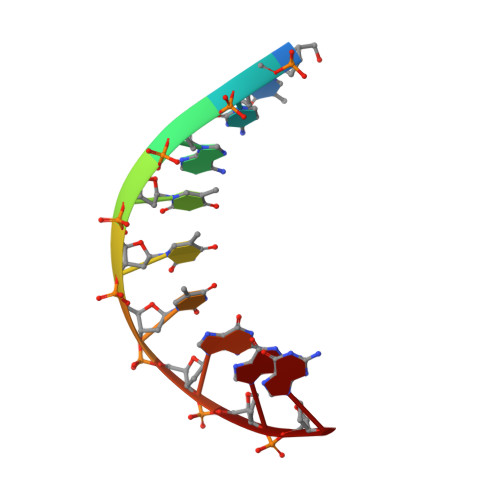Structure of chimeric duplex junctions: solution conformation of the retroviral Okazaki-like fragment r(ccca)d(AATGA).d(TCATTTGGG) from Moloney murine leukemia virus.
Salazar, M., Fedoroff, O.Y., Reid, B.R.(1996) Biochemistry 35: 8126-8135
- PubMed: 8679564
- DOI: https://doi.org/10.1021/bi9528917
- Primary Citation of Related Structures:
1OKA - PubMed Abstract:
We have determined the solution structure of the synthetic chimeric duplex r(ccca)d(AATGA).d(TCATTTGGG) by two-dimensional NMR, distance geometry, restrained molecular dynamics, and full relaxation matrix simulation of the two-dimensional nuclear Overhauser effect spectra at various mixing times. The chimeric strand of this duplex consists of the last four residues of the tRNA(Pro) primer for (-) strand DNA synthesis of Moloney murine leukemia virus and the first five residues of the (-) strand DNA produced by extending this primer; the complementary DNA strand corresponds to the (+) strand product from this template. The hybrid section of this chimeric duplex assumes a structure similar to that found for pure hybrid duplexes of mixed sequence, while the DNA section assumes a conformation closer to B-form DNA. There is significant distortion of the duplex at the hybrid-DNA junction which is manifested in marked changes in the helical parameters buckle, roll, and tip, changes in glycosidic torsion angles, and changes in the backbone torsion angles delta, epsilon, and zeta. The sugar conformations also undergo large changes, from heteromerous puckers in the hybrid section to a more B-form in the DNA section. Furthermore, the intrastrand phosphate separation in the chimeric strand is more typical of A-form duplexes in the RNA section but more like B-form duplexes in the DNA section. In the DNA section the minor groove width changes gradually from B-form at the periphery and approaches hybrid-like dimensions closer to the junction. The structural discontinuities act synergistically to produce a bend of 18 +/- 3 degrees at the junction. The global structure of this sequence is similar to that previously found in the chemically analogous Okazaki fragment r(gcg)d(TATACCC).d(GGGTATACGC) in solution. Such structure homology suggests a possible link between structure and function with respect to the recognition and cleavage of the junction RNA residues in both retroviral chimeras and Okazaki fragments during reverse transcription and normal DNA replication.
Organizational Affiliation:
Drug Dynamics Institute, College of Pharmacy, University of Texas at Austin, 78712, USA.















